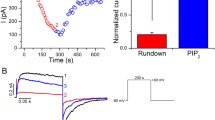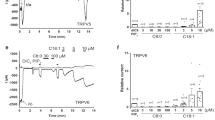Abstract
We investigated the effects of different protein kinase C (PKC) activators on Na+ currents using the conventional whole-cell and the inside-out macropatch voltage-clamp techniques in mouse neuroblastoma cells (N1E-115). Two different categories of PKC activators were investigated: the cis-unsaturated fatty acids (CUFAs): oleic (cis-9-octadecenoic), linoleic (cis-9-12-octadecadienoic), and linolenic acid (cis-9-12-15-octadecatrienoic), and, the diacylglycerol (DAG) derivative 1-2-dioctanoyl-sn-glycerol (DOG). These substances caused the following alterations on Na+ currents: (i) Na+ currents were attenuated as a function of voltage. While DOG attenuated both inward and outward Na+ currents in a monotonic and continuous voltage-dependent manner, CUFAs preferentially attenuated inward currents; (ii) the steady-state activation curve of Na+ currents shifted to more depolarized voltages; (iii) opposite to the activation curve, the steady-state inactivation curve of Na+ channels (h curve) shifted to more hyperpolarized voltages; (iv) the time course of inactivation development was accelerated by PKC activators, while the recovery from inactivation was not affected; (v) substances that inhibit different metabolic pathways (PKC activation, cyclooxygenase, lipooxygenase, and P-450 pathways) did not prevent the effects of PKC activators on Na+ currents. One fully saturated fatty acid (octadecanoic acid), a trans-unsaturated fatty acid (trans-9-octadecenoic), and different phorbol esters did not affect Na+ currents; (vi) effects of different PKC activators on Na+ currents were completely reversible. These observations suggest that PKC activators might interact with Na+ channels directly. These direct effects must be taken into consideration in evaluating the overall effect of PKC activation on Na+ channels. Moreover, it is likely that this direct interaction could account, at least in part, for the diversity of effects of PKC activators on Na+ channels.
Similar content being viewed by others
References
Asaoka, Y., Nakamura, S., Yoshida, K., Nishizuka, Y. 1992. Protein kinase C, calcium and phospholipid degradation. Trends Biochem. Sci. 17:414–417
Bowlby, M.R., Levitan, I.B. 1994. Diacylglycerol induces fast inactivation in slowly inactivating voltage-gated potassium channels. Biophys. J. 66:A208 (Abstr.)
Cahalan, M.D., Shapiro, B.I. 1976. Current and frequency dependent block of sodium channels by strychnine. Biophys. J. 16:76a (Abstr.)
Catterall, W.A. 1992. Cellular and molecular biology of voltage-gated sodium channels. Physiol. Rev. 72:S15-S48
Cukierman, S. 1992. Characterization of K+ currents in rat malignant lymphocytes (Nb2 cells). J. Membrane Biol. 126:147–157
Egan, R.W., Gale, P.H. 1984. Comparative biochemistry of lipoxygenase inhibitors. In: Prostaglandins, Leukotrienes, and Lipoxins. J.M. Bailey, editor. pp. 593–607. Plenum Press, New York
Fernandez, J.M., Fox, A.P., Krasne, S. 1984. Membrane patches and whole-cell membranes: a comparison of electrical properties in rat clonal (GH3) pituitary cells. J. Physiol. 356:565–585
Fraser, D.D., Hoehn, K., Weiss, S., MacVicar, B.A. 1993. Arachidonic acid inhibits sodium currents and synaptic transmission in cultured striatal neurons. Neuron 11:633–640
Godoy, C.M., Cukierman, S. 1994. Multiple effects of protein kinase C activators on Na+ channels in mouse neuroblastoma cells. J. Membrane Biol. 140:101–110
Hamill, O.P., Marty, A., Neher, E., Sakmann, B., Sigworth, F.J. 1981. Improved patch-clamp techniques for high resolution current recording from cells and cell-free membrane patches. Pfluegers Arch. 391:85–100
Hanck, D.A., Sheets, M.F. 1992. Time-dependent changes in kinetics of Na+ current in single canine cardiac Purkinje cells. Am. J. Physiol. 262:H1197-H1207
Hille, B. 1992. Ionic channels of excitable membranes. 2nd. edition, Sinauer Associates Inc., Sunderland, MA
Hockberger, P., Toselli, Swandulla, D., Lux, H.D. 1989. A diacylglycerol analogue reduces neuronal calcium currents independently of protein kinase C activation. Nature 338:340–342
Kaczmarek, L.K., Levitan, I.B. 1987. Neuromodulation. The biochemical control of neuronal excitability. Oxford University Press, New York
Kim, D., Clapham, D. 1989. Potassium channels in cardiac cells activated by arachidonic acid and phospholipids. Science 244:1174–1176
Li, M., West, J.W., Numann, R., Murphy, B.J., Scheuer, T., Catterall, W.A. 1993. Convergent regulation of sodium channels by protein kinase C and cAMP-dependent protein kinase. Science 261:1439–1442
Linden, D.J., Routtenberg, A. 1989. Cis-fatty acids, which activate protein kinase C, attenuate Na+ and Ca2+ currents in mouse neuroblastoma cells. J. Physiol. 419:95–119
Meves, H. 1994. Modulation of ion channels by arachidonic acid. Prog. Neurobiol. 43:175–186
Numann, R., Catterall, W.A., Scheuer, T. 1991. Functional modulation of brain sodium channels by protein kinase C phosphorylation. Science 254:115–118
Ordway, R.W., Walsh, J.V., Singer, J.J. 1989. Arachidonic acid and other fatty acids directly activate potassium channels in smooth muscle cells. Science 244:1176–1179
Seyama, L, Wu, C.H., Naharashi, T. 1980. Current-dependent block of nerve membrane sodium channels by paragracine. Biophys. J. 29:531–538
Shen, T.W., Winter, C.A. 1979. Chemical and biological studies on indomethacin, sulindac and analogs. Adv Drug Res 12:89–245
Shimada, T., Somlyo, A.P. 1992. Modulation of voltage dependent Ca channel current by arachidonic acid and other long-chain fatty acids in rabbit intestinal smooth muscle. J. Gen. Physiol. 100:27–44
Takenaka, T., Horie, H., Hori, H. 1987. Effects of fatty acids on membrane currents in the squid axon. J. Membrane Biol. 95:113–120
Wieland, S.J., Fletcher, J.E., Gong, Q.H. 1992. Differential modulation of a sodium conductance in skeletal muscle by intracellular and extracellular fatty acids. Am. J. Physiol. 263:C308-C312
Author information
Authors and Affiliations
Additional information
This work was supported in part by a grant-in-aid from the American Heart Association (National Center).
Rights and permissions
About this article
Cite this article
Renganathan, M., Godoy, C.M.G. & Cukierman, S. Direct modulation of Na+ currents by protein kinase C activators in mouse neuroblastoma cells. J. Membarin Biol. 144, 59–69 (1995). https://doi.org/10.1007/BF00238417
Received:
Revised:
Issue Date:
DOI: https://doi.org/10.1007/BF00238417




